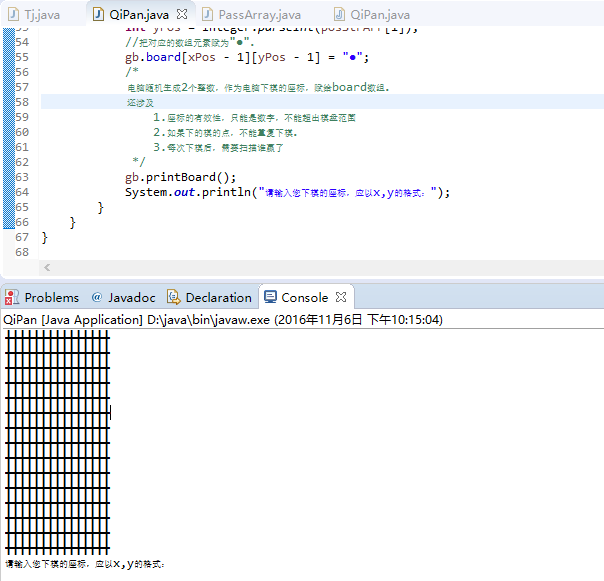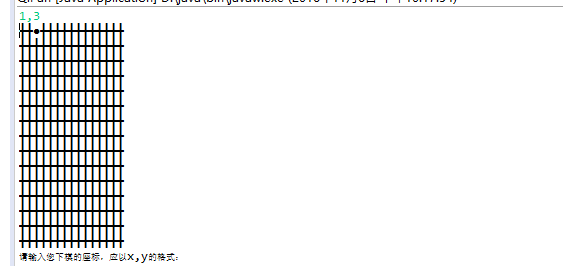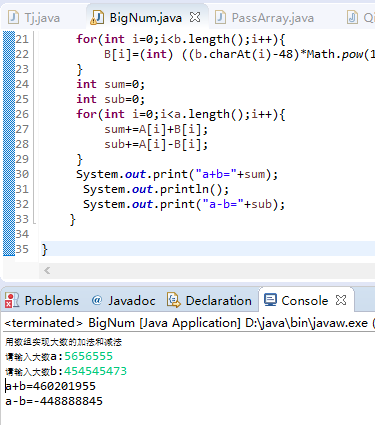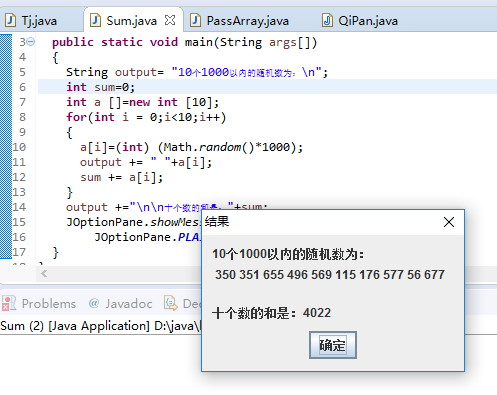1.数组棋盘
import java.io.*;
public class QiPan
{
//定义一个二维数组来充当棋盘
private String[][] board;
//定义棋盘的大小
private static int BOARD_SIZE = 15;
public void initBoard()
{
//初始化棋盘数组
board = new String[BOARD_SIZE][BOARD_SIZE];
//把每个元素赋为"╋",用于在控制台画出棋盘
for (int i = 0 ; i < BOARD_SIZE ; i++)
{
for ( int j = 0 ; j < BOARD_SIZE ; j++)
{
board[i][j] = "╋";
}
}
}
//在控制台输出棋盘的方法
public void printBoard()
{
//打印每个数组元素
for (int i = 0 ; i < BOARD_SIZE ; i++)
{
for ( int j = 0 ; j < BOARD_SIZE ; j++)
{
//打印数组元素后不换行
System.out.print(board[i][j]);
}
//每打印完一行数组元素后输出一个换行符
System.out.print("
");
}
}
public static void main(String[] args)throws Exception
{
QiPan gb = new QiPan();
gb.initBoard();
gb.printBoard();
//这是用于获取键盘输入的方法
BufferedReader br = new BufferedReader(new InputStreamReader(System.in));
String inputStr = null;
System.out.println("请输入您下棋的座标,应以x,y的格式:");
//br.readLine():每当在键盘上输入一行内容按回车,刚输入的内容将被br读取到。
while ((inputStr = br.readLine()) != null)
{
//将用户输入的字符串以逗号(,)作为分隔符,分隔成2个字符串
String[] posStrArr = inputStr.split(",");
//将2个字符串转换成用户下棋的座标
int xPos = Integer.parseInt(posStrArr[0]);
int yPos = Integer.parseInt(posStrArr[1]);
//把对应的数组元素赋为"●"。
gb.board[xPos - 1][yPos - 1] = "●";
/*
电脑随机生成2个整数,作为电脑下棋的座标,赋给board数组。
还涉及
1.座标的有效性,只能是数字,不能超出棋盘范围
2.如果下的棋的点,不能重复下棋。
3.每次下棋后,需要扫描谁赢了
*/
gb.printBoard();
System.out.println("请输入您下棋的座标,应以x,y的格式:");
}
}
}


2.编写一个程序将整数转化为汉字
import java.io.*;
public class Test1 {
public static void main(String[] args) {
//数据字典!
char c[]={'零','壹','贰','叁','肆','伍','陆','柒','捌','玖'};
//等待输入!
System.out.print("请输入一个阿拉伯数字: ");
BufferedReader br=new BufferedReader(new InputStreamReader(System.in));
//得到输入!
try {
String input=br.readLine();
for(int count=0;count<input.length();count++){
//转成数字
char temp=input.charAt(count);
switch (temp){
case '1':System.out.print(c[1]);break;case '2':System.out.print(c[2]);break;
case '3':System.out.print(c[3]);break;case '4':System.out.print(c[4]);break;
case '5':System.out.print(c[5]);break;case '6':System.out.print(c[6]);break;
case '9':System.out.print(c[9]);break;case '8':System.out.print(c[8]);break;
case '0':System.out.print(c[0]);break;default:break;
}
}
} catch (IOException e) {
e.printStackTrace();
}
}
}

3大数
前面几讲介绍过JDK所提供的BigInteger能完成大数计算,如果不用它,直接使用数组表达大数,你能实现相同的功能吗? 要求: (1)用你的大数类实现加和减两个功能 (2)阅读BigInteger类源码,弄清楚它是使用什么算法实现加减乘除四种运算的? (3)通过互联网查找大数运算的相关资料,给你的大数类添加乘、除、求阶乘等其它功能。
(1)BigInteger历史介绍
在java中,存在很多种类的数据类型,例如byte short char int float double long,而BigInteger属于其中一个比较特殊的数据类型,也是本教程关注的重点。BigInteger在JDK1.1中就已经存在了,属于java.math包的类。从名字来看,BigInteger比Integer表示数值的范围更大一些。BigInteger类的基本结构如下所示:
java.lang.Object
|_java.lang.Number
|_java.math.BigInteger
BigInteger已实现的接口:Serializable, Comparable<BigInteger>
(2)BigInteger是不可变的任意精度的整数。所有操作中,都以二进制补码形式表示 BigInteger(如 Java 的基本整数类型)。BigInteger 提供所有 Java 的基本整数操作符的对应物,并提供 java.lang.Math 的所有相关方法。另外,BigInteger 还提供以下运算:模算术、GCD 计算、质数测试、素数生成、位操作以及一些其他操作。
(3)BigInteger属性分析
下面看看BigInteger有哪些重点的属性,主要的有下面三个:
(1)final int signum
signum属性是为了区分:正负数和0的标志位,JDK注释里面已经说的很明白了:
The signum of this BigInteger: -1 for negative, 0 for zero, or 1 for positive. Note that the BigInteger zero must have a signum of 0. This is necessary to ensures that there is exactly one representation for each BigInteger value.
(2)final int[] mag
mag是magnitude的缩写形式,mag数组是存储BigInteger数值大小的,采用big-endian的顺序,也就是高位字节存入低地址,低位字节存入高地址,依次排列的方式。JDK原文注释如下:
The magnitude of this BigInteger, in big-endian order: the zeroth element of this array is the most-significant int of the magnitude. The magnitude must be "minimal" in that the most-significant int (mag[0]) must be non-zero. This is necessary to ensure that there is exactly one representation for each BigInteger value. Note that this implies that the BigInteger zero has a zero-length mag array.
(3)final static long LONG_MASK = 0xffffffffL;
This mask is used to obtain the value of an int as if it were unsigned。
import java.util.Scanner;
public class BigNum {
public static void main(String[] args) {
// TODO Auto-generated method stub
int aa,bb;
System.out.println("用数组实现大数的加法和减法");
System.out.print("请输入大数a:");
Scanner scan=new Scanner(System.in);
String a=scan.next();
System.out.print("请输入大数b:");
String b=scan.next();
int A[]=new int[100];
int B[]=new int[100];
for(int i=0;i<a.length();i++){
A[i]=(int) ((a.charAt(i)-48)*Math.pow(10,a.length()-i-1));
}
for(int i=0;i<b.length();i++){
B[i]=(int) ((b.charAt(i)-48)*Math.pow(10,b.length()-i-1));
}
int sum=0;
int sub=0;
for(int i=0;i<a.length();i++){
sum+=A[i]+B[i];
sub+=A[i]-B[i];
}
System.out.print("a+b="+sum);
System.out.println();
System.out.print("a-b="+sub);
}
}

4.随机数
import javax.swing.*;
public class Sum {
public static void main(String args[])
{
String output= "10个1000以内的随机数为:
";
int sum=0;
int a []=new int [10];
for(int i = 0;i<10;i++)
{
a[i]=(int) (Math.random()*1000);
output += " "+a[i];
sum += a[i];
}
output +="
十个数的和是:"+sum;
JOptionPane.showMessageDialog(null,output,"结果",
JOptionPane.PLAIN_MESSAGE);
}
}

开始-》int=0 sum=0-》i<10如果大于10就输出总合-》a[i]=Math。random()*1000-》sum+=a[i]-》
输出a[i]-》输出sum-》结束 。。